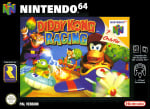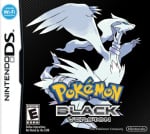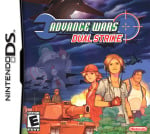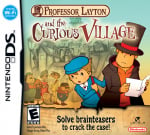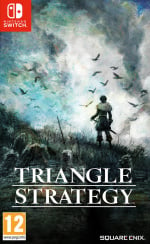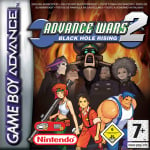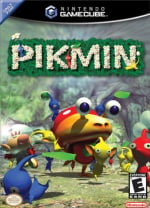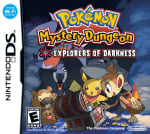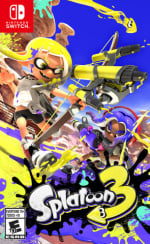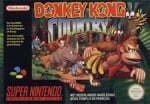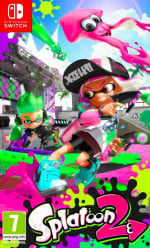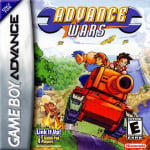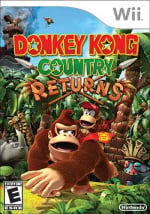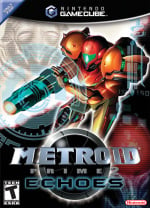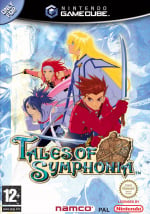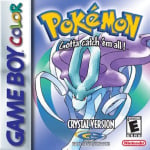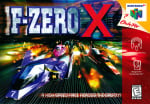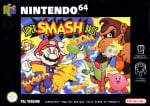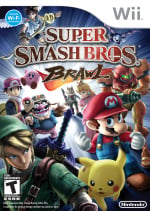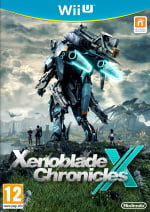
The Famicom is now 40 years old. Time, huh? That’s four whole decades of 8-bit Nintendo games, many of which defined entire genres and birthed enduring characters and series that would go forth and flourish in future console generations and are still starring in system-sellers today.
In honour of 40 years of quality from our video game purveyors of choice, we’re publishing this list of the 100 Best Nintendo Games ever made. We’re talking first-party published titles here, most of which Nintendo developed in-house, although you’ll see some select second-party gems nestled in amongst all the gold from Kyoto’s finest.
As with many of our ranked lists, this selection of the finest Nintendo games available to humanity is governed by each game’s User Ratings on our database. Yes, this is a reader-ranked list, and a dynamic one that can change in real-time as individual game scores go up and down. As such, registered Nintendo Life users can click on the stars beside each game below and score them out of 10 and exert your influence on the ranking. If you’ve rated these games before, good on you! If not, it’s never too late!
A couple of notes before we begin. We’ve excluded a handful of games to prevent repetition. The Wii U version of Breath of the Wild, for example, is incredible, but not enough to warrant having Breath of the Wild occupy two spots in the Top 10 (apologies for the spoiler there, but c’mon!). In cases where we’ve deemed the two entries to be too similar, we’ve kept the higher of the two (which, perhaps surprisingly, isn’t always the HD or Deluxe Switch version). We’ve also removed all compilations in order to give more individual games a chance to shine. Complaints to the usual address.
Okay, that’s enough prevarication. On with the countdown of the 100 Top Nintendo games of all time, starting with…

Publisher: Nintendo / Developer: Rare
Diddy Kong Racing did for Mario Kart 64 pretty much what Banjo-Kazooie would soon do for Super Mario 64; namely, take the template put down by Nintendo and expand on it with colour and creativity to produce far more than a mere homage. DKR expanded the single-player into an adventure and the addition of planes and hovercraft required much larger, more complex circuits to race around. The game also provided the console debuts of Banjo and Conker. What more do you want, jam on it?

Publisher: Nintendo / Developer: Game Freak
Pokémon Black and White may not have the added nostalgia of HeartGold and SoulSilver, but they’re up there with some of the best in the series. What they lack in links to the past they gain by recreating the sense of discovery felt when embarking on that first Pokémon journey.
Black and White arguably suffer in reputation from being the only games in the series (thus far) to have direct numbered sequels set in the same region (albeit visiting new locations). Despite being shoved to the back of the queue in some people’s minds, these introductions to Gen V are still fantastic games and well worth revisiting.

Publisher: Nintendo / Developer: Intelligent Systems
Advance Wars: Dual Strike isn’t hugely different to its two GBA predecessors, and at times it can feel like a new ‘mission pack’, but when the base experience is this good, that’s no bad thing. Additions such as having two CO characters in a battle enable you to fight on two fronts and add extra variety. Survival and Combatmodes add to the replayability, ensuring that like its predecessors there’s plenty to keep you occupied.
This was the penultimate outing for the ‘Wars’ series on DS; the 2008 sequel Advance Wars: Days of Ruin was the last time Intelligent Systems took to the battlefield in a game that didn’t have ‘Fire Emblem’ in the title. With the release of the fabulous Fire Emblem: Three Houses, the developer has another strategy hit on its hands, but we’d still love to see a return of the Wars series someday. Until then, we’ll have to make do with returning to previous entries, including this gem.

Publisher: Nintendo / Developer: Level-5
Professor Layton and the Curious Village was the first in the puzzle-solving detective series to introduce the world to the titular professor and Luke, the professor’s apprentice and very own Watson. Level-5’s series brought in a whole new audience of gamers with its particular brand of mysterious adventure, great characters and writing to match. It was games like this that opened up video gaming to an audience who had previously thought it wasn’t for them and the franchise’s continued success proves it wasn’t a fluky one-off. The sequels refined the formula, but it was pretty much perfect right off the bat.

Publisher: Nintendo / Developer: Square Enix
Triangle Strategy is an absolute triumph for Artdink and Square Enix, a fantastic mix of satisfyingly strategic battles, an excellent choice-driven campaign narrative and top-notch world-building, all of which come together to form one of the finest tactical RPGs we’ve played in a very long time. There’s an absolute ton of content here, with a huge story featuring multiple paths to take depending on the choices you make and several properly impactful endings to enjoy on return visits. Serenoa Wollfort’s epic journey is a joy from start to finish, a grand and ambitious adventure that stands proud as one of the very finest examples of its genre on Switch.

Publisher: Nintendo / Developer: Intelligent Systems
Coming a couple of years after the original GBA entry in Intelligent Systems’ Wars series, Advance Wars 2 might not have shaken things up a whole lot, but it offered a slew of nice additions, as well as a fun new campaign to work your way through. Certain COs were tweaked to be less overpowered (Max, anyone?) making this a more balanced game than its predecessor. It’s arguably more of the same, but when the first course was so delicious, who wouldn’t want a second helping?

Publisher: Nintendo / Developer: Nintendo EAD
Shigeru Miyamoto takes up gardening and before you know it he’s cracked out Nintendo’s version of the Real-Time Strategy genre! Featuring tiny little plant creatures that you order around in groups to pick up rubbish, harvest fruit and battle bugs and other beasties, it’s disarmingly charming and utterly bloodthirsty at the same time. You become very protective of the little critters that do your bidding and there’s an immense feeling of guilt when you accidentally command a legion into a watery grave or awaken a nest of sleeping monsters that proceed to munch though great swathes of your army. The sequel might have had some great refinements and additions, but there’s something to be said about the taut design and focus of the original Pikmin. We like it a lot.

Publisher: Nintendo / Developer: Nintendo
This pair of Pokémon games from Chunsoft were sequels to Pokémon Mystery Dungeon: Red Rescue Team and Blue Rescue Team, games which (unusually) straddled the GBA and DS respectively, using the latter’s GBA cartridge slot to interface between the two. Both Explorers of Time and Explorers of Darkness were DS-only and brought along all the Gen IV Pokémon. The game sees you transformed into a Pocket Monster at the beginning and, of course, you’ll need both versions if you want to catch ’em all. Two years later the enhanced Explorers of Sky would arrive with added ‘mons, dungeons and features. These games’ repetitive gameplay isn’t everyone’s cup of tea, but if you’re after dungeon crawling with added cuteness from your favourite franchise critters, it doesn’t get much better than this.

Publisher: Nintendo / Developer: Nintendo
Splatoon 3 is more of the same, but refined to borderline mechanical perfection. It’s the most fun we’ve had with an online shooter in years, and for series veterans it makes Splatoon 2 feel entirely redundant for all but its unique single-player content. It feels like the development team has solved every problem the Splatoon community was bleating on about, and then fixed some more that we didn’t even realise were problems until they were fixed. There’s nothing revolutionary about it compared to its predecessors, and it’s perhaps missing a Big New Idea™ that you might expect after five years, but Splatoon 3 is the pinnacle of the series, and the pinnacle of shooters on Switch.

Publisher: Nintendo / Developer: Rare
This classic 16-bit platformer from Rare revitalised the character of Donkey Kong and introduced new members of the DK clan in a game that looked unimaginably impressive running on Super NES hardware back in the day. Donkey Kong Country‘s faux 3D sprites may not have aged too gracefully, but the underlying gameplay is as solid as it was in 1994 — this is still a thoroughly enjoyable romp.

Publisher: Nintendo / Developer: Nintendo EPD
Splatoon 2 is just about everything you could ask for from a sequel. It builds on everything the original online team shooter set up and then some; almost every single major issue people had with the first game has been resolved, showing that Nintendo is genuinely listening and wants to deliver the absolute best experience possible. It maintains the freshness you’d expect and throws in countless big and small changes and additions, every one of them for the better. Splatoon 2 is simply ink-redible.

Publisher: Nintendo / Developer: Intelligent Systems
The first Advance Wars is a turn-based tactical classic. It might not have the huge amount of COs and new units that its sequels would bring, but as a result it feels more balanced and approachable; it generally feels very fair, even if you lose. And in those rare instances that it risks infuriating you, the immensely charming graphics and top notch music keep a smile on your face. We love a bit of Fire Emblem, but we’ve had our fingers crossed for years that Advance Wars will return some day. Keep ’em crossed.

Publisher: Nintendo / Developer: Retro Studios
Retro Studios revival of Rare’s treasured Donkey Kong Country on SNES came after the developer had successfully reinvented Nintendo’s Metroid as an exploratory first-person shooter, so perhaps we shouldn’t have been surprised that the team was able to recapture the spirit of Rare’s DKC platformers three console generations later with Donkey Kong Country Returns. However, it still came as something of a surprise just how good the game turned out, reimagining the SNES template for the 21st Century.
The 3DS port is equally impressive, but you really can’t go wrong with whatever version you can get your hands on. When it comes to resurrections, it seems Retro is your go-to studio and DKC returned in fabulous form on Wii.

Publisher: Nintendo / Developer: Retro Studios
Often considered to be the weakest entry in the Prime trilogy, Metroid Prime 2: Echoes nevertheless boasts the same brand of explorative first-person action that made the first game such a success, although with an increased difficulty and lacklustre multiplayer mode which took the shine off it for some players. We’d recommend playing it on Wii with the added bonus of pointer controls if the difficulty is an issue, but however you play, this sequel is still an incredibly good game.

Publisher: Nintendo / Developer: Namco
The GameCube entry in Namco’s Tales series, Tales of Symphonia, could be fairly described as an RPG for non-fans of the genre. The battle system is active and forgoes the static menus you might expect in favour of the ‘Multi-Line Linear Motion Battle System’ which makes things more dynamic for players who like that sort of thing. This was the first entry to feature 3D graphics and although the plot might be a little workaday if you’re at all familiar with the genre, there’s a lot to love here. The game was also released for PS2 in Japan, and PS3 worldwide, so the GameCube isn’t the only place to catch up with Lloyd and the gang.

Publisher: Nintendo / Developer: Game Freak
Pokémon Crystal is the perfect swan song to what many fans consider the best generation of Pokémon games and the series’ final Game Boy Color entry. It featured a plethora of welcome new features over the base games — including the ability to play as a female character for the first time — plus more things to do, tweaked graphics and UI, and a slight notch up in the challenge department.
Crystal took what Pokémon Gold and Silver did so marvellously and made Johto worth exploring once more – and Kanto for the umpteenth time for that matter. It truly proves that nostalgia is far from the sole factor that makes this game so great to pick up again.

Publisher: Nintendo / Developer: Nintendo EAD
Forum wars continue to wage over whether F-Zero X or its successor on GameCube is the superior white-knuckle futuristic racer. Both are essential, of course. The 64-bit entry is metal: pure, simple, guitar-screeching, all-out metal. EAD stripped back extraneous detail to achieve the smoothest, most blistering and nail-bitingly precise racing experience. At this speed, on these dizzying tracks, even the tiniest prod on the spindly analogue stick matters, and the original N64 pad offers peak precision for micro adjustments which make the difference between gracefully sweeping through a corner with nary a pixel to spare… or catching said corner and ricocheting between barriers to an explosive, humiliating retirement.
How much more metal could this get? None. None more metal. Flaming skulls and chromed motorcycles would actually reduce the metal content of this game.

Publisher: Nintendo / Developer: HAL Laboratory
Bearing in mind how carefully Nintendo began managing its characters and their image after the misfire of the (first) Super Mario Bros. movie in the early ’90s, it’s remarkable that the original Super Smash Bros. and its inter-franchise scrapping got off the drawing board at HAL Laboratory. Fortunately, Masahiro Sakurai’s crossover brawler was permitted to exist.
At the time, the idea of a ‘platform’ fighting game without health bars was pretty revolutionary. Instead, as you beat up your opponent, they’d become more vulnerable to knockback from your attacks, with the aim being to knock them out of the arena entirely. Catering for up to four players with a simple control scheme (especially compared to other fighting games) and the addition of weapons and power-ups to spice things up, this first Smash was a rock-solid foundation for a series that would become one of the world’s biggest fighting franchises.
The number of combatants and complexity of the N64 original may pale in comparison with later rosters, which plucked from the annals of video gaming history, but we still look back fondly on the very first time we had the opportunity to open a can of whoop-ass on Pikachu.

Publisher: Nintendo / Developer: Nintendo
The third entry in the scrap ’em up series, Super Smash Bros. Brawl was the first to introduce Sonic the Hedgehog and Solid Snake, and included the lauded Subspace Emissary mode.
Picking up the baton from the celebrated GameCube entry, Brawl pushed the series in an all-encompassing direction as far as content was concerned, and set the precedent for the ‘more is more’ approach to stages, fighters, music, and more that kept Masahiro Sakurai occupied eight-days-a-week for many years after.

Publisher: Nintendo / Developer: Monolith Soft
Xenoblade Chronicles X is sprawling, diverse, complex and entrancing. It utilised the Wii U’s capabilities not only to produce a beautiful world, but showed how something as simple as a map on the GamePad screen can be invaluable. What’s most impressive is the dynamism and impression of freedom in play – level caps and grinding are naturally part of the equation, yet they’re managed within a structure where even small missions or Affinity quests greatly enhance the narrative and sense of place. To truly experience the story of this human colony and the vast planet Mira requires exploration and patience, and Monolith Soft found an impressive balance in bringing its vast range of gameplay systems and mechanics together. Occasional bottlenecks are infrequent and easily overcome in the broader experience, and overall Xenoblade Chronicles X delivers a hugely impressive RPG adventure. It was an enormous accomplishment for Monolith Soft and an irresistible part of the Wii U library.
The Famicom is now 40 years old. Time, huh? That’s four whole decades of 8-bit Nintendo games, many of which defined entire genres and birthed enduring characters and series that would go forth and flourish in future console generations and are still starring in system-sellers today.
In honour of 40 years of quality from our video game purveyors of choice, we’re publishing this list of the 100 Best Nintendo Games ever made. We’re talking first-party published titles here, most of which Nintendo developed in-house, although you’ll see some select second-party gems nestled in amongst all the gold from Kyoto’s finest.
As with many of our ranked lists, this selection of the finest Nintendo games available to humanity is governed by each game’s User Ratings on our database. Yes, this is a reader-ranked list, and a dynamic one that can change in real-time as individual game scores go up and down. As such, registered Nintendo Life users can click on the stars beside each game below and score them out of 10 and exert your influence on the ranking. If you’ve rated these games before, good on you! If not, it’s never too late!
A couple of notes before we begin. We’ve excluded a handful of games to prevent repetition. The Wii U version of Breath of the Wild, for example, is incredible, but not enough to warrant having Breath of the Wild occupy two spots in the Top 10 (apologies for the spoiler there, but c’mon!). In cases where we’ve deemed the two entries to be too similar, we’ve kept the higher of the two (which, perhaps surprisingly, isn’t always the HD or Deluxe Switch version). We’ve also removed all compilations in order to give more individual games a chance to shine. Complaints to the usual address.
Okay, that’s enough prevarication. On with the countdown of the 100 Top Nintendo games of all time, starting with…

Publisher: Nintendo / Developer: Rare
Diddy Kong Racing did for Mario Kart 64 pretty much what Banjo-Kazooie would soon do for Super Mario 64; namely, take the template put down by Nintendo and expand on it with colour and creativity to produce far more than a mere homage. DKR expanded the single-player into an adventure and the addition of planes and hovercraft required much larger, more complex circuits to race around. The game also provided the console debuts of Banjo and Conker. What more do you want, jam on it?

Publisher: Nintendo / Developer: Game Freak
Pokémon Black and White may not have the added nostalgia of HeartGold and SoulSilver, but they’re up there with some of the best in the series. What they lack in links to the past they gain by recreating the sense of discovery felt when embarking on that first Pokémon journey.
Black and White arguably suffer in reputation from being the only games in the series (thus far) to have direct numbered sequels set in the same region (albeit visiting new locations). Despite being shoved to the back of the queue in some people’s minds, these introductions to Gen V are still fantastic games and well worth revisiting.

Publisher: Nintendo / Developer: Intelligent Systems
Advance Wars: Dual Strike isn’t hugely different to its two GBA predecessors, and at times it can feel like a new ‘mission pack’, but when the base experience is this good, that’s no bad thing. Additions such as having two CO characters in a battle enable you to fight on two fronts and add extra variety. Survival and Combatmodes add to the replayability, ensuring that like its predecessors there’s plenty to keep you occupied.
This was the penultimate outing for the ‘Wars’ series on DS; the 2008 sequel Advance Wars: Days of Ruin was the last time Intelligent Systems took to the battlefield in a game that didn’t have ‘Fire Emblem’ in the title. With the release of the fabulous Fire Emblem: Three Houses, the developer has another strategy hit on its hands, but we’d still love to see a return of the Wars series someday. Until then, we’ll have to make do with returning to previous entries, including this gem.

Publisher: Nintendo / Developer: Level-5
Professor Layton and the Curious Village was the first in the puzzle-solving detective series to introduce the world to the titular professor and Luke, the professor’s apprentice and very own Watson. Level-5’s series brought in a whole new audience of gamers with its particular brand of mysterious adventure, great characters and writing to match. It was games like this that opened up video gaming to an audience who had previously thought it wasn’t for them and the franchise’s continued success proves it wasn’t a fluky one-off. The sequels refined the formula, but it was pretty much perfect right off the bat.

Publisher: Nintendo / Developer: Square Enix
Triangle Strategy is an absolute triumph for Artdink and Square Enix, a fantastic mix of satisfyingly strategic battles, an excellent choice-driven campaign narrative and top-notch world-building, all of which come together to form one of the finest tactical RPGs we’ve played in a very long time. There’s an absolute ton of content here, with a huge story featuring multiple paths to take depending on the choices you make and several properly impactful endings to enjoy on return visits. Serenoa Wollfort’s epic journey is a joy from start to finish, a grand and ambitious adventure that stands proud as one of the very finest examples of its genre on Switch.

Publisher: Nintendo / Developer: Intelligent Systems
Coming a couple of years after the original GBA entry in Intelligent Systems’ Wars series, Advance Wars 2 might not have shaken things up a whole lot, but it offered a slew of nice additions, as well as a fun new campaign to work your way through. Certain COs were tweaked to be less overpowered (Max, anyone?) making this a more balanced game than its predecessor. It’s arguably more of the same, but when the first course was so delicious, who wouldn’t want a second helping?

Publisher: Nintendo / Developer: Nintendo EAD
Shigeru Miyamoto takes up gardening and before you know it he’s cracked out Nintendo’s version of the Real-Time Strategy genre! Featuring tiny little plant creatures that you order around in groups to pick up rubbish, harvest fruit and battle bugs and other beasties, it’s disarmingly charming and utterly bloodthirsty at the same time. You become very protective of the little critters that do your bidding and there’s an immense feeling of guilt when you accidentally command a legion into a watery grave or awaken a nest of sleeping monsters that proceed to munch though great swathes of your army. The sequel might have had some great refinements and additions, but there’s something to be said about the taut design and focus of the original Pikmin. We like it a lot.

Publisher: Nintendo / Developer: Nintendo
This pair of Pokémon games from Chunsoft were sequels to Pokémon Mystery Dungeon: Red Rescue Team and Blue Rescue Team, games which (unusually) straddled the GBA and DS respectively, using the latter’s GBA cartridge slot to interface between the two. Both Explorers of Time and Explorers of Darkness were DS-only and brought along all the Gen IV Pokémon. The game sees you transformed into a Pocket Monster at the beginning and, of course, you’ll need both versions if you want to catch ’em all. Two years later the enhanced Explorers of Sky would arrive with added ‘mons, dungeons and features. These games’ repetitive gameplay isn’t everyone’s cup of tea, but if you’re after dungeon crawling with added cuteness from your favourite franchise critters, it doesn’t get much better than this.

Publisher: Nintendo / Developer: Nintendo
Splatoon 3 is more of the same, but refined to borderline mechanical perfection. It’s the most fun we’ve had with an online shooter in years, and for series veterans it makes Splatoon 2 feel entirely redundant for all but its unique single-player content. It feels like the development team has solved every problem the Splatoon community was bleating on about, and then fixed some more that we didn’t even realise were problems until they were fixed. There’s nothing revolutionary about it compared to its predecessors, and it’s perhaps missing a Big New Idea™ that you might expect after five years, but Splatoon 3 is the pinnacle of the series, and the pinnacle of shooters on Switch.

Publisher: Nintendo / Developer: Rare
This classic 16-bit platformer from Rare revitalised the character of Donkey Kong and introduced new members of the DK clan in a game that looked unimaginably impressive running on Super NES hardware back in the day. Donkey Kong Country‘s faux 3D sprites may not have aged too gracefully, but the underlying gameplay is as solid as it was in 1994 — this is still a thoroughly enjoyable romp.

Publisher: Nintendo / Developer: Nintendo EPD
Splatoon 2 is just about everything you could ask for from a sequel. It builds on everything the original online team shooter set up and then some; almost every single major issue people had with the first game has been resolved, showing that Nintendo is genuinely listening and wants to deliver the absolute best experience possible. It maintains the freshness you’d expect and throws in countless big and small changes and additions, every one of them for the better. Splatoon 2 is simply ink-redible.

Publisher: Nintendo / Developer: Intelligent Systems
The first Advance Wars is a turn-based tactical classic. It might not have the huge amount of COs and new units that its sequels would bring, but as a result it feels more balanced and approachable; it generally feels very fair, even if you lose. And in those rare instances that it risks infuriating you, the immensely charming graphics and top notch music keep a smile on your face. We love a bit of Fire Emblem, but we’ve had our fingers crossed for years that Advance Wars will return some day. Keep ’em crossed.

Publisher: Nintendo / Developer: Retro Studios
Retro Studios revival of Rare’s treasured Donkey Kong Country on SNES came after the developer had successfully reinvented Nintendo’s Metroid as an exploratory first-person shooter, so perhaps we shouldn’t have been surprised that the team was able to recapture the spirit of Rare’s DKC platformers three console generations later with Donkey Kong Country Returns. However, it still came as something of a surprise just how good the game turned out, reimagining the SNES template for the 21st Century.
The 3DS port is equally impressive, but you really can’t go wrong with whatever version you can get your hands on. When it comes to resurrections, it seems Retro is your go-to studio and DKC returned in fabulous form on Wii.

Publisher: Nintendo / Developer: Retro Studios
Often considered to be the weakest entry in the Prime trilogy, Metroid Prime 2: Echoes nevertheless boasts the same brand of explorative first-person action that made the first game such a success, although with an increased difficulty and lacklustre multiplayer mode which took the shine off it for some players. We’d recommend playing it on Wii with the added bonus of pointer controls if the difficulty is an issue, but however you play, this sequel is still an incredibly good game.

Publisher: Nintendo / Developer: Namco
The GameCube entry in Namco’s Tales series, Tales of Symphonia, could be fairly described as an RPG for non-fans of the genre. The battle system is active and forgoes the static menus you might expect in favour of the ‘Multi-Line Linear Motion Battle System’ which makes things more dynamic for players who like that sort of thing. This was the first entry to feature 3D graphics and although the plot might be a little workaday if you’re at all familiar with the genre, there’s a lot to love here. The game was also released for PS2 in Japan, and PS3 worldwide, so the GameCube isn’t the only place to catch up with Lloyd and the gang.

Publisher: Nintendo / Developer: Game Freak
Pokémon Crystal is the perfect swan song to what many fans consider the best generation of Pokémon games and the series’ final Game Boy Color entry. It featured a plethora of welcome new features over the base games — including the ability to play as a female character for the first time — plus more things to do, tweaked graphics and UI, and a slight notch up in the challenge department.
Crystal took what Pokémon Gold and Silver did so marvellously and made Johto worth exploring once more – and Kanto for the umpteenth time for that matter. It truly proves that nostalgia is far from the sole factor that makes this game so great to pick up again.

Publisher: Nintendo / Developer: Nintendo EAD
Forum wars continue to wage over whether F-Zero X or its successor on GameCube is the superior white-knuckle futuristic racer. Both are essential, of course. The 64-bit entry is metal: pure, simple, guitar-screeching, all-out metal. EAD stripped back extraneous detail to achieve the smoothest, most blistering and nail-bitingly precise racing experience. At this speed, on these dizzying tracks, even the tiniest prod on the spindly analogue stick matters, and the original N64 pad offers peak precision for micro adjustments which make the difference between gracefully sweeping through a corner with nary a pixel to spare… or catching said corner and ricocheting between barriers to an explosive, humiliating retirement.
How much more metal could this get? None. None more metal. Flaming skulls and chromed motorcycles would actually reduce the metal content of this game.

Publisher: Nintendo / Developer: HAL Laboratory
Bearing in mind how carefully Nintendo began managing its characters and their image after the misfire of the (first) Super Mario Bros. movie in the early ’90s, it’s remarkable that the original Super Smash Bros. and its inter-franchise scrapping got off the drawing board at HAL Laboratory. Fortunately, Masahiro Sakurai’s crossover brawler was permitted to exist.
At the time, the idea of a ‘platform’ fighting game without health bars was pretty revolutionary. Instead, as you beat up your opponent, they’d become more vulnerable to knockback from your attacks, with the aim being to knock them out of the arena entirely. Catering for up to four players with a simple control scheme (especially compared to other fighting games) and the addition of weapons and power-ups to spice things up, this first Smash was a rock-solid foundation for a series that would become one of the world’s biggest fighting franchises.
The number of combatants and complexity of the N64 original may pale in comparison with later rosters, which plucked from the annals of video gaming history, but we still look back fondly on the very first time we had the opportunity to open a can of whoop-ass on Pikachu.

Publisher: Nintendo / Developer: Nintendo
The third entry in the scrap ’em up series, Super Smash Bros. Brawl was the first to introduce Sonic the Hedgehog and Solid Snake, and included the lauded Subspace Emissary mode.
Picking up the baton from the celebrated GameCube entry, Brawl pushed the series in an all-encompassing direction as far as content was concerned, and set the precedent for the ‘more is more’ approach to stages, fighters, music, and more that kept Masahiro Sakurai occupied eight-days-a-week for many years after.

Publisher: Nintendo / Developer: Monolith Soft
Xenoblade Chronicles X is sprawling, diverse, complex and entrancing. It utilised the Wii U’s capabilities not only to produce a beautiful world, but showed how something as simple as a map on the GamePad screen can be invaluable. What’s most impressive is the dynamism and impression of freedom in play – level caps and grinding are naturally part of the equation, yet they’re managed within a structure where even small missions or Affinity quests greatly enhance the narrative and sense of place. To truly experience the story of this human colony and the vast planet Mira requires exploration and patience, and Monolith Soft found an impressive balance in bringing its vast range of gameplay systems and mechanics together. Occasional bottlenecks are infrequent and easily overcome in the broader experience, and overall Xenoblade Chronicles X delivers a hugely impressive RPG adventure. It was an enormous accomplishment for Monolith Soft and an irresistible part of the Wii U library.

